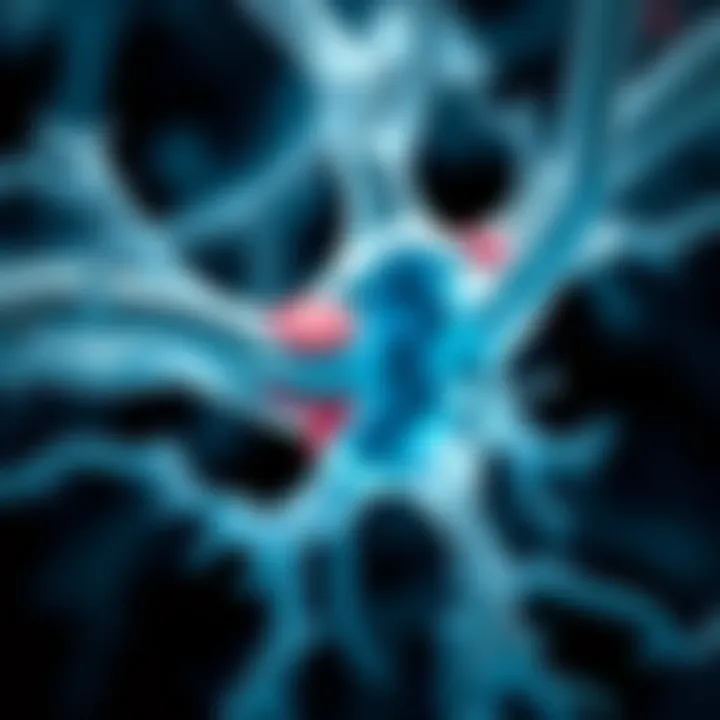Understanding Myasthenia Gravis: Insights and Advances


Research Context
Myasthenia gravis represents one of the more complex challenges in the realm of autoimmune disorders, primarily affecting the neuromuscular junction where nerves communicate with muscles. This disorder leads to notable muscle weakness, varying significantly in intensity and pattern, often depending on the time of day or physical activity. It is not merely a condition impacting individual's physical capabilities but extends its reach into the psychological and social spheres of life.
Background Information
Understanding myasthenia gravis isn't just about grasping the symptoms. It’s essential to appreciate the intricate dynamics of the immune system at play. The body erroneously produces antibodies that block or destroy the receptors for acetylcholine — a crucial neurotransmitter. If we imagine these receptors as keys to a lock, myasthenia gravis effectively alters the locking mechanism, leaving doors unused and unresponsive when the brain attempts to signal the muscles.
Importance of the Study
A comprehensive examination of this condition holds substantial weight not only for clinical practitioners but also for researchers and educators in the field. Awareness and understanding can accelerate diagnostics and treatment strategies. Moreover, ongoing investigations reveal emerging therapies that could dramatically change patient outcomes. By unpacking the nuances of myasthenia gravis, both from a historical and contemporary lens, we can better appreciate the breadth of its implications on patient life and care, leading to refined management strategies.
Discussion
Interpretation of Results
Research surrounding myasthenia gravis has yielded insights that may shift previous paradigms in treatment. Recent studies indicate variable responses among patients to traditional therapies, which point to the need for personalized treatment plans. For instance, the efficacy of cholinesterase inhibitors, a mainstay in management, often sees a rollercoaster effect, where improvement can be juxtaposed against periods of exacerbation. This oscillating nature underlines the complexity clinicians face. It’s as if the treatment landscape resembles a chess game, where every move requires consideration of unpredictable outcomes.
Comparison with Previous Research
When we compare enlightened perspectives in understanding myasthenia gravis against earlier findings, a clear evolution is observable. Past decades relied heavily on diagnostics marked by a standard set of tests and treatment protocols. However, ongoing research emphasizes a more tailored approach, acknowledging the considerable variation in patient responses. For instance, work done in the past few years has shown that lifestyle factors uniquely influence disease progression.
"The journey through myasthenia gravis is not one-size-fits-all; every patient’s experience is colored by their unique biological canvas."
As studies from sources like the National Institutes of Health (NIH) and peer-reviewed journals reveal, the landscape of potential treatments is vast and continuously developing, allowing comparisons that could yield from merely effective to transformative results in patient care.
Understanding Myasthenia Gravis
Understanding Myasthenia Gravis is crucial, not just for the medical community but also for patients and families affected by this condition. This section sets the stage for a deeper investigation into the complexities of Myasthenia Gravis, shedding light on its definition, epidemiology, and how it impacts lives. Getting a handle on the basic elements of this autoimmune neuromuscular disorder allows individuals to grasp the challenges faced and the necessity for effective management strategies.
The importance of comprehending Myasthenia Gravis lies in several factors:
- Awareness of Symptoms: Knowing the symptoms helps in timely diagnosis, which can be a game changer in managing the condition.
- Stakeholder Involvement: Patients, caregivers, and healthcare professionals must be on the same page to foster a supportive environment for those wrestling with this disorder.
- Research and Development: As we unravel the intricacies of Myasthenia Gravis, ongoing research can explore novel treatment options, ultimately enhancing quality of life for those affected.
Through this article, we aim to bridge the knowledge gap about Myasthenia Gravis while providing insights on the best practices for care and management. In doing so, it not only benefits those living with the condition but also arms healthcare providers with the information necessary to deliver better, informed care.
Definition and Overview
Myasthenia Gravis is more than a mouthful; it's a condition that significantly affects muscle strength due to an error in communication between nerves and muscles. In essence, it occurs when the immune system mistakenly produces antibodies that block or destroy nicotinic acetylcholine receptors at the neuromuscular junction. This disruption results in the reduced ability of the muscles to respond to nerve impulses, leading to characteristic muscular weakness.
Symptomatically, individuals may experience weakness in the eyes, face, throat, and limbs, often worsening after periods of activity. You can think of it like trying to talk to someone through a noisy crowd; the message can get lost, leaving muscles unable to carry out their usual tasks effectively.
Epidemiology and Prevalence
Looking at the epidemiology, Myasthenia Gravis is not as rare as you might think; it affects around 20 out of every 100,000 people globally. Interestingly, it affects both men and women, but the age of onset can differ. For instance, women generally develop the condition in their 20s to 30s, while men tend to present symptoms later in life, around their 60s.
- Gender Disparities: Women are more frequently diagnosed at a younger age, leading to an early initiation of treatment and varying clinical approaches between genders.
- Incidence Rate: Various studies suggest that the incidence of the disorder may be on the rise, possibly due to better diagnostic methods and increased awareness.
What’s particularly telling is that Myasthenia Gravis may coexist with other autoimmune conditions, such as thyroid disorders or rheumatoid arthritis, which can complicate its management. Understanding the prevalence patterns helps public health officials in planning effective healthcare resources and aids in designing informative programs that raise awareness about the disorder.
Pathophysiology
The pathophysiology of myasthenia gravis is a crucial aspect to understand, as it provides insights into how this complex autoimmune disorder manifests its symptoms and affects patients' lives. By examining the underlying mechanisms, we can better grasp not just the condition itself, but also the rationale behind various treatment approaches. The intricate interplay between the immune system and neuromuscular transmission highlights the nuances of this disease, which can often be overshadowed by its clinical symptoms.
The Autoimmune Component
At the heart of myasthenia gravis lies a dysfunctional immune response that leads to the production of antibodies targeting the acetylcholine receptor at the neuromuscular junction. This mechanism disrupts normal communication between nerves and muscles. It's like a bad game of telephone, where the message gets garbled along the way. Instead of a clear signal telling muscles to contract, the signal falters, leading to muscle weakness.
Research shows that this autoimmune response is often triggered by various factors, including genetic predispositions and environmental influences. The thymus gland, an important part of the immune system, plays a pivotal role; abnormalities in its structure or function are frequently observed in patients with myasthenia gravis. The changes in the thymus can contribute to the generation of antibodies, further aggravating the disorder.
Role of Acetylcholine and Receptors
Acetylcholine is a neurotransmitter that is essential for muscle contraction, binding to receptors on muscle cells to initiate movement. In myasthenia gravis, the immune system’s antibodies block or destroy these receptors, preventing acetylcholine from exerting its effects. Think of it as a lock and key system: the acetylcholine serves as the key, and the receptor is the lock. When antibodies block the keyhole, the key can’t fit, and thus, the chain reaction that leads to muscle contraction fails to occur.
This failure leads to the hallmark symptoms of muscle fatigue and weakness, which can worsen with prolonged activity. Understanding this interaction is critical for developing medications that can enhance communication at the neuromuscular junction, providing relief and improving muscle function for those affected.
Genetic Factors


Genetics also plays an important role in myasthenia gravis, although it is not strictly viewed as a hereditary condition. Certain gene variations may predispose individuals to autoimmune disorders, which suggests that the genetic makeup could influence the likelihood of developing myasthenia gravis. In particular, variations in major histocompatibility complex genes have been implicated in the disease's pathogenesis.
On top of that, familial patterns indicate that there may be an inherited susceptibility to conditions like myasthenia gravis. While not every person with a family history will develop the disorder, the genetic landscape adds another layer of complexity in understanding who might be at risk and how they can be monitored.
"Genetic makeup may not just play a role in predisposition but also in how individuals respond to treatment, potentially influencing outcomes."
In summary, the pathophysiology of myasthenia gravis is multi-faceted. Recognizing the diverse components—autoimmune reactions, the role of acetylcholine, and genetic risk factors—provides a more nuanced understanding of the disorder as a whole. Such comprehension is essential not only for clinicians and researchers but also for patients navigating their diagnosis and treatment options.
Clinical Manifestations
Understanding the clinical manifestations of myasthenia gravis is crucial for both those affected and healthcare professionals. Recognizing these symptoms is often the first step toward diagnosis and effective management of the condition. While myasthenia gravis primarily impacts muscle strength, it manifests differently in each individual. This makes it essential for patients and caregivers to identify and report symptoms accurately, enhancing the likelihood of a timely diagnosis and better treatment outcomes.
Common Symptoms
The hallmark of myasthenia gravis lies in its unique symptoms, which typically include:
- Muscle Weakness: This varies depending on the muscle groups involved. Commonly affected areas are the eyes, face, throat, and limbs.
- Ptosis: Drooping of one or both eyelids can occur, making it visually apparent.
- Diplopia: Double vision is another frequent complaint, which can make daily tasks more challenging.
- Difficulty Swallowing: Muscles responsible for swallowing may weaken, leading to aspiration issues.
- Weakness in Arms and Legs: People may feel they can’t lift objects or climb stairs without excessive effort.
Recognizing these symptoms early can be crucial in managing the disease effectively. Individuals experiencing these signs are encouraged to seek medical advice. The symptoms can fluctuate, improving with rest and worsening with prolonged activity, which is a distinguishing characteristic of myasthenia gravis.
Neuromuscular Fatigue
Neuromuscular fatigue is an integral part of the disease's narrative. Many patients report a significant dip in muscle ability as the day progresses, which can be quite puzzling for those unfamiliar with myasthenia gravis. It’s not merely tired muscles after a long day; instead, it’s a profound weakness that can leave one feeling as though they’ve run a marathon despite limited activity.
While resting can provide temporary relief, the fatigue may return upon activity. This unpredictable nature of fatigue underscores the importance of thoughtful management plans. Some common strategies include:
- Pacing Activities: Breaking tasks into smaller, manageable pieces can prevent excessive fatigue.
- Scheduled Rest Periods: Integrating rest into daily routines can help maintain functionality.
The recognition and understanding of neuromuscular fatigue allow both patients and practitioners to tailor the management strategies to better suit individual needs.
Crisis Presentation
A myasthenic crisis, a severe exacerbation of symptoms, represents a medical emergency that requires prompt attention. During a crisis, the strength of respiratory muscles can be significantly compromised, leading to difficulty breathing. It is characterized by rapid onset and can be triggered by factors including:
- Infection: Illness can exacerbate existing symptoms.
- Stress: Emotional or physical stress often worsens the situation.
- Changes in Medications: Alterations in treatment can lead to a sudden decline in muscle strength.
Having a plan in place for crisis situations is vital for patients. It’s essential for family and caregivers to recognize the signs early and act swiftly. Immediate medical care may involve measures such as intravenous immunoglobulin or plasmapheresis to stabilize the situation.
In summary, the clinical manifestations of myasthenia gravis significantly impact patients’ lives. A clear understanding of common symptoms, the unique experience of neuromuscular fatigue, and the potential for crisis presentations are crucial for effective management of the disorder. Such knowledge not only empowers patients but also enables healthcare providers to optimize care strategies tailored to individual needs.
Diagnosis
Understanding the diagnosis of myasthenia gravis is a critical facet in highlighting the complexity of this autoimmune disorder. Proper identification is imperative not only for the initiation of timely treatment but also for the management of symptoms that can substantially impact a patient’s quality of life. The diagnosis encompasses a multifaceted approach, incorporating various methods to ascertain the presence and severity of the condition. By emphasizing the significance of accurate diagnosis, the article sheds light on how it influences treatment decisions, prognostic assessments, and patient education.
Clinical Assessment
The foundation of diagnosing myasthenia gravis lies in thorough clinical assessment. This process often begins with a detailed patient history, where healthcare providers seek to understand symptoms and their progression, as well as any familial history of autoimmune disorders. Observational examinations play a significant role, particularly in assessing neuromuscular function. Clinicians focus on identifying key signs, such as muscle weakness that worsens with activity, ptosis (drooping of one or both eyelids), and diplopia (double vision). Such signs are vital indicators and can guide the provider towards a more formal diagnostic pathway.
In many cases, specialists may employ specific clinical tests that look for fatigue in muscle strength. The force of selected muscle groups may be assessed multiple times to determine any variations in strength, which helps in understanding the fluctuating nature of the symptoms. This variability is a hallmark of myasthenia gravis, distinguishing it from other neuromuscular disorders.
Serological Tests
Following the clinical assessment, serological tests play an essential role in confirming the diagnosis. These blood tests are designed to detect specific antibodies that are commonly present in individuals with myasthenia gravis. Notably, antibodies against acetylcholine receptors and muscle-specific kinase are the two most prevalent types that are checked.
- Acetylcholine receptor antibodies: Found in approximately 80% of individuals with generalized myasthenia gravis, these antibodies interfere with communication between nerves and muscles.
- MuSK antibodies: Present in a smaller subset of patients, especially those who may test negative for acetylcholine receptor antibodies, these can also lead to muscle weakness by impacting neuromuscular transmission.
The results of serological tests can provide robust evidence to support the clinical findings and guide treatment options. Furthermore, negative test results do not necessarily rule out the disease, emphasizing the need for a holistic approach to diagnosis.
Electrophysiological Studies
Electrophysiological studies, including repetitive nerve stimulation and single-fiber electromyography (SFEMG), are invaluable tools in diagnosing myasthenia gravis. These studies help quantify the degree of neuromuscular transmission failure.
- Repetitive Nerve Stimulation: This test assesses the muscles’ response to a series of electrical impulses. A decrease in the muscle’s electrical response upon repeated stimulation indicates a problem with neuromuscular transmission, common in myasthenia gravis patients.
- Single-Fiber Electromyography (SFEMG): This is a more sensitive test and can detect even subtle impairments in neuromuscular transmission. It measures the electrical activity of individual muscle fibers and is often used when other tests fail to provide a clear diagnosis.
The integration of clinical assessments, serological tests, and electrophysiological studies creates a thorough diagnostic process for myasthenia gravis, ensuring that healthcare providers can tailor appropriate management strategies effectively.
Treatment Approaches


When tackling myasthenia gravis, understanding treatment approaches is crucial. They not only modify disease progression but also enhance the quality of life for patients. Given that myasthenia gravis alters muscle strength and endurance, the effective management hinges on targeted therapies aimed at alleviating symptoms and addressing underlying autoimmune processes. This section unpacks the available options, offering insights into both pharmacological and surgical interventions.
Medications
The medley of medications plays a vital role in managing myasthenia gravis. It's like a toolbox—each tool designed to deal with a specific problem. From medications that bolster the communication between nerves and muscles to those that quell the immune response, each has something unique to offer.
Anticholinesterase Agents
Anticholinesterase agents, such as pyridostigmine, are frontline treatments for mitigating muscle weakness in myasthenia gravis. Their primary function is to inhibit the breakdown of acetylcholine, a neurotransmitter, leading to prolonged activation at the neuromuscular junction. This characteristic makes these agents invaluable in enhancing muscle contraction strength and endurance. One major advantage is their quick onset of action, allowing for immediate symptom relief.
However, there are notable downsides. While these agents can be effective in the short term, they may lead to side effects such as gastrointestinal discomfort and increased salivation. Balancing these pros and cons is essential, as they can impact patient compliance and overall treatment outcomes.
Immunosuppressive Therapies
Immunosuppressive therapies—like corticosteroids and azathioprine—target the underlying autoimmune response that plagues individuals with myasthenia gravis. By dampening the activity of the immune system, these medications help reduce the production of antibodies that disrupt neuromuscular communication. Their key characteristic lies in their ability to provide long-term disease control, making them especially beneficial for patients with more severe manifestations of the disease.
Nonetheless, these therapies come with a significant caveat. The suppression of the immune system can escalate the risk of infections, requiring careful monitoring and preventive measures. Thus, physicians must weigh the long-term benefits against potential hazards, ensuring each patient's unique situation is considered.
Monoclonal Antibodies
Monoclonal antibodies, a more recent entry into the treatment arena, have shown promise in treating myasthenia gravis. Drugs like eculizumab specifically target complement components, which play a role in the pathophysiology of the disease. The primary feature of these antibodies is their precision, as they seek to dismantle specific pathways of disease progression. Patients often experience quickly resolved symptoms and improved muscle function when using these therapies.
However, the cost is an important consideration. Monoclonal antibodies can come with a hefty price tag. Moreover, potential adverse effects, such as increased susceptibility to infections, underscore the need for thorough discussions regarding their use. The balance between superior efficacy and affordability is often a tightrope walk for both patients and healthcare providers.
Surgical Interventions
Surgical options also enter the conversation when treating myasthenia gravis. Unlike medications, surgeries can offer definitive solutions for some patients. Thymectomy is a primary intervention here, aimed at alleviating symptoms and, in some cases, even inducing remission.
Thymectomy
Thymectomy involves the surgical removal of the thymus gland, which plays a pivotal role in immune function. This procedure is believed to contribute significantly to symptom relief in myasthenia gravis patients, particularly those with thymoma or other thymic abnormalities. The characteristic advantage of thymectomy is its potential to lead to long-term improvement in muscle strength, sometimes even achieving remission in select patients.
However, not everyone is a candidate for this surgery. Risks include complications typical of any surgical procedure, such as infection or complications from anesthesia. Patients must engage in thorough discussions with specialists to assess whether the benefits of thymectomy outweigh potential risks.
Impact on Disease Course
The impact of thymectomy on the disease course can be profound. Studies have indicated that patients who undergo this surgery often experience fewer severe manifestations and find themselves relying less on medications as time progresses. This unique aspect is particularly valuable, making thymectomy a worthwhile consideration for certain individuals dealing with myasthenia gravis.
Nevertheless, the decision is not without its complications. Skilled surgical teams and postoperative care are paramount to a successful outcome. Each patient’s medical history and specific condition play a crucial role in determining whether this intervention is appropriate. Thus, personalized treatment plans that take into account the multifaceted nature of myasthenia gravis are essential.
The management of myasthenia gravis requires a tailored approach that incorporates various treatment modalities, balancing efficacy with safety for the best quality of life for patients.
By delving into both pharmacological and surgical strategies, healthcare providers can navigate the complexities of myasthenia gravis, ultimately embarking on the path to improved patient outcomes and better quality of life. Understanding these approaches equips those involved—be it patients, caregivers, or healthcare professionals—with the insight needed to make informed choices amidst the challenging landscape of this autoimmune disorder.
Ongoing Research Perspectives
Understanding the ongoing research perspectives in myasthenia gravis is essential not only for enhancing our knowledge of the disease but also for improving patient outcomes. Research efforts focus on uncovering new therapeutic strategies, understanding disease mechanisms more deeply, and watching out for the future implications of long-term management for patients. As this field continues to evolve, new insights may pave the way for innovative treatments that could change the landscape of care for those affected by myasthenia gravis.
Novel Therapeutic Targets
Recent research efforts have shifted towards identifying novel therapeutic targets that could offer more effective treatments for myasthenia gravis. Traditional therapies often focus on symptom management rather than addressing underlying disease mechanisms. This has led to a growing interest in personalized medicine, where treatments can be tailored to the specific autoimmune profile of the patient.
- Emerging Biologics: These agents work by specifically targeting immune pathways that contribute to the disease process. For instance, agents like eculizumab, which inhibits complement activation, are being studied for their potential to address the pathological processes involved in myasthenia gravis.
- Investigational Drugs: New drugs geared towards modulating the immune response show promise. Researchers are exploring molecules that can selectively inhibit immune responses without broadly suppressing immunity, which could minimize side effects.
- Gene Therapy: Some visionary studies are looking at gene therapy as a means to directly alter the immune landscape. This approach could ultimately lead to long-term remission rather than continuous management of symptoms.
The potential for these novel targets to offer better responses and allow for a more holistic approach to treatment could greatly enhance patients' quality of life.
Understanding Long-term Outcomes
In the realm of myasthenia gravis, understanding long-term outcomes is a critical part of ongoing research. The nature of this disorder suggests that many patients will experience fluctuations in their disease, and knowing how to manage these variations effectively is paramount.
"Long-term outcomes are not solely about survival but also about quality of life and the ability to engage in everyday activities."
- Disease Progression Studies: Researching how myasthenia gravis progresses over time can provide insights for better management strategies. These studies offer important data on predictors of improvement or decline, helping healthcare providers make informed treatment decisions.
- Quality of Life Assessments: Longitudinal studies focusing on patient-reported quality of life can yield rich insights into the everyday impact of myasthenia gravis. Factors such as fatigue, physical limitations, and psychological well-being are often included in these assessments.
- Healthcare Utilization Trends: Understanding how patients interact with healthcare systems over time can reveal much about the disease burden. Effective tracking of these patterns can help in resource allocation and in designing support services for patients.
As this research evolves, it’s crucial for patients and clinicians to stay informed. The goal is not just better treatments but ensuring that the lives of patients affected by myasthenia gravis are enriched and supported through effective management strategies.
Patient Care and Management


Effective management of myasthenia gravis is not just about treating the symptoms. It involves a comprehensive approach that requires understanding the complexities of this autoimmune disorder. Patient care and management serve as the foundation for improving quality of life for those affected. The notion is straightforward: managing the condition effectively can lead to better outcomes and reduced complications. A tailored management plan can encompass medication, lifestyle adjustments, and education, all aimed at empowering patients to lead a fulfilling life despite their diagnosis.
Multidisciplinary Approach
Employing a multidisciplinary approach to myasthenia gravis is instrumental. This strategy brings together various healthcare professionals, including neurologists, physiotherapists, dietitians, and occupational therapists. Each specialist contributes unique insights and skills, ensuring that treatment is comprehensive. For instance, neurologists focus on medical management while physiotherapists design exercise regimens that help in maintaining muscle strength without causing undue fatigue.
- Benefits of a Multidisciplinary Approach:
- Holistic Care: It ensures that every aspect of a patient’s health is addressed.
- Tailored Treatment Plans: Different specialists can offer tailored recommendations suited to the patient's unique needs.
- Continuous Monitoring: Team members can collaboratively monitor progress and adjust treatments as necessary.
In essence, collaboration enhances the effectiveness of treatment plans, as it offers a well-rounded perspective that encompasses physical, emotional, and nutritional aspects.
Importance of Patient Education
When it comes to managing myasthenia gravis, patient education is key. Educating patients helps them understand their condition better, which can significantly affect their ability to manage symptoms. Knowledge empowers individuals; they can make informed decisions about their treatment and lifestyle.
- Key Educational Focus:
- Understanding myasthenia gravis and its implications for daily life.
- Awareness of potential symptoms and when to seek medical help.
- Knowledge of medications and possible side effects.
- Lifestyle adaptations that can help manage fatigue and weakness, such as taking rest periods or modifying daily tasks.
An educated patient is more likely to adhere to treatment plans and communicate effectively with healthcare providers. Moreover, peer support groups can serve as valuable resources, allowing individuals to share experiences and strategies for managing day-to-day challenges.
"Knowledge is power. When patients are well-informed, they can advocate for their needs and engage proactively in their care."
Quality of Life Considerations
Understanding how myasthenia gravis affects the quality of life for those who live with it is crucial. This autoimmune disorder does not just impact muscle function; it drags along a host of challenges that can seep into all aspects of daily living. The importance of considering these elements can’t be overstated, as they shape how individuals cope with their condition. Tackling myasthenia gravis isn’t just about addressing the physical symptoms; it’s deeply tied to enhancing the overall well-being of the affected individuals.
Impact on Daily Living
The implications of myasthenia gravis on daily life can feel like a heavy anchor weighing someone down. From the moment a person wakes up, the struggle with fatigue can influence even the simplest tasks. Many patients report that routine activities, such as climbing stairs, walking, or even lifting a cup, may become monumental challenges. The condition can lead to limitations in mobility and inconsistencies in strength. This unpredictability can result in frustration and a sense of helplessness.
- Fatigue: The sheer exhaustion that follows even minimal exertion can be debilitating. Many individuals find they must plan their days around their energy levels.
- Social Activities: Enjoying a night out or participating in social gatherings may become fraught with apprehension. The worry of sudden weakness can cause people to hesitate in making plans.
- Work Impact: The professional life of someone living with myasthenia gravis might face hurdles. Job performance can be affected as a result of sporadic fatigue, putting a strain on both personal ambitions and financial stability.
A practical approach to ameliorate these daily living impacts often lies in understanding oneself better—going slow, pacing out activities, and making adjustments in one’s environment.
Support Systems and Resources
Navigating the waters of myasthenia gravis is often smoother with a solid support system. This encompasses not only family and friends but also healthcare providers, support groups, and community resources. Feeling understood and supported is fundamental; it makes individuals more resilient against the emotional toll the disorder can sometimes bring.
- Family and Friends: A close-knit circle can make all the difference. Those closest can be an invaluable source of encouragement, helping to take on tasks that might be overwhelming to manage alone.
- Support Groups: Connecting with others facing similar challenges can offer not just friendship but also practical tips and emotional support. Sharing experiences fosters a sense of belonging and reduces feelings of isolation.
- Educational Resources: Staying informed about the latest treatments and research can empower individuals. Websites such as Myasthenia Gravis Foundation of America provide essential information on managing the condition.
- Medical Professionals: Regular visits to healthcare providers are non-negotiable. They can help tailor an individual’s treatment plan and provide necessary adjustments when life changes.
"No one is as capable of helping you understand your battles as those who face them too."
In summary, recognizing and addressing the quality of life considerations in myasthenia gravis is paramount. This condition's full impact extends beyond physical symptoms, shaping an individual’s daily existence and emotional health. By tapping into various support systems and remaining aware of personal limitations, individuals can find ways to adapt, cope, and enhance their overall quality of life.
Resources for further exploration:
Understanding the significance of these considerations can help both those affected and their caregivers navigate the complex and often challenging landscape of myasthenia gravis.
Closure
In the scope of this article, the conclusion section plays a pivotal role by tying together the various threads explored throughout this comprehensive examination of myasthenia gravis. It encapsulates the key insights, ultimately aiding readers—ranging from students to professionals—in grasping the significance of understanding this debilitating autoimmune disorder. Reflection on the multi-layered aspects of myasthenia gravis emphasizes the urgency of research and heightened awareness among healthcare practitioners.
Summary of Key Points
The complexity of myasthenia gravis can be summarized through the following critical insights:
- Autoimmunity at Play: It stems from an autoimmune response targeting the communication between nerves and muscles, primarily involving acetylcholine.
- Diverse Symptoms: The symptoms can vary widely, including muscle weakness and fatigue, but also encompass serious crises that require immediate medical attention.
- Variety of Diagnoses: Accurate diagnosis calls for a combination of clinical evaluations, diagnostic tests, and patient histories, ensuring that treatment can be appropriately tailored.
- Diverse Treatment Modalities: Treatments range from medication to surgical options, presenting a multi-faceted approach towards managing and alleviating symptoms.
- Multidisciplinary Management: Effective patient care demands a collaborative approach, emphasizing the need for interdisciplinary teamwork in both diagnosis and ongoing management.
Future Directions in Research
Looking to the horizon, several avenues are opening up in the research of myasthenia gravis:
- Genetic Insights: There’s a need to delve deeper into genetic predispositions that may contribute to the development of myasthenia gravis. Understanding these factors could potentially lead to targeted therapies.
- Novel Therapeutic Targets: Researchers are actively investigating new drugs and treatment methods that might specifically alter immune responses, potentially leading to better control of the disorder.
- Long-term Outcomes: More studies are needed to ascertain the long-term effects and quality of life implications for individuals living with myasthenia gravis, ensuring that treatment approaches evolve in tandem with emerging evidence.
- Patient-Centered Research: Encouraging studies that incorporate patient experiences and feedback will be crucial in developing holistic management strategies that address both physical and emotional facets of the disorder.
Consequently, the future will rely on the ingenuity of ongoing research and collaborative efforts aimed at enhancing patient experiences and outcomes. As the understanding of this multifaceted condition grows, it is imperative that professionals remain updated on innovations that could significantly alter the landscape of myasthenia gravis treatment and management.
"The best way to predict the future is to invent it."
- Alan Kay















